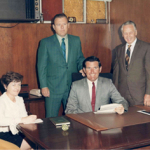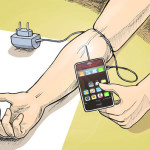 One night, about six months back, two of our employees on the graveyard shift overdosed on cocaine. They left the plant around 12:30am — all of this caught on video — walked across the street, and bought from a dealer waiting on the corner. They later claimed they did it because they were tired. The cocaine turned out laced with a near fatal dose of fentanyl, a common additive to drugs, I later learned, because the high is so addictive. One staggered back into the factory and collapsed in the restroom, with no pulse, saved by the actions of a co-worker. The other was later found near death as well. Police and ambulances converged on the scene, and the shift supervisor called our president, Pallavi Joyappa, to come deal with the situation.
One night, about six months back, two of our employees on the graveyard shift overdosed on cocaine. They left the plant around 12:30am — all of this caught on video — walked across the street, and bought from a dealer waiting on the corner. They later claimed they did it because they were tired. The cocaine turned out laced with a near fatal dose of fentanyl, a common additive to drugs, I later learned, because the high is so addictive. One staggered back into the factory and collapsed in the restroom, with no pulse, saved by the actions of a co-worker. The other was later found near death as well. Police and ambulances converged on the scene, and the shift supervisor called our president, Pallavi Joyappa, to come deal with the situation.
How to deal with the employees involved? We asked them to tell the truth about what happened, a truth we more or less already knew. One decided not to, and we let him go. The other did, and we kept him on condition he stop using. When random testing showed that was harder to do than anyone thought, we helped him find a rehab center and told him to take the time he needed to get well. We held his job and let him keep his seniority during his 90 day leave. He returned clean, and remains so, and continues to be a productive printing press helper.
If I tell this story, and our leadership’s role in the aftermath, to senior executives at large companies, they typically can’t believe what they’re hearing. They seem to think we must run a crazy workplace. But those of us at the other end of the business spectrum like Emerald Packaging, with $90 million in sales, a small executive staff, such high touch come with the territory. Over the last decade, we’ve helped employees cope with the suicide of a beloved colleague, the murder of another, the untimely death of a third, and a long-time employee who lost two children, one also to suicide. Keeping our team together and focused through these ordeals has involved listening, hugs as people cried in my arms, even saying the rosary with a group gathered to mourn with the mother grieving her child.
I really can’t imagine leadership any other way. We’ve helped an employee ransom his brother kidnapped in Mexico, paid a tax lien for another, paid for educations, and so on. I look at it very similar to how Pope Francis imagines the Catholic Church. He sees the church as a field hospital tending to the wounded, which every one of us is in some way. We do the same at Emerald, because we have to. People bring their pains and sorrows and crosses to work every day, and unless we show authentic empathy and care, we can’t bring them together in this common project, making a product people need, building community around a common goal where they can transform that negative energy into something positive and tangible, allowing them to provide for their family’s by building a company, and a strong one, that will sustain itself for years to come.
Of course, that means making a profit. We’re a business, so we have to. Otherwise we can’t provide for people, invest and plan for the future. Still, that project — which ultimately falls to the company leadership team — occurs in a setting where real people work and live. And that must be respected, or really, what’s the point? Money alone doesn’t build a successful family or community or business or city or country. Running a smaller company is a human project, and with that comes all the messiness that us human’s live in. So, we pay for an employee’s drug rehab, give him the time he needs, and hold his job until he returns, hopefully with the stamina to avoid drugs and become a productive, loyal member of our team.
Covid sharpened this leadership approach. Since we were an essential business, we asked people to come to work despite the risks as we understood them. As the leader, I knew I couldn’t hide at home while asking others to show-up, so each day I went in. And every day for months, I worried I might kill someone. I knew our company couldn’t survive if people didn’t work, so we made a pact to keep them safe as possible. Our team worked tirelessly, creating protocols, finding ways to encourage safety, to get people to care for each other, and when someone did get sick, support them with groceries and pay as they sat in isolation for two weeks at home. It worked. We didn’t have an internal transmission of Covid until a year and a half after the first national cases. And the company not only survived, but against all odds thrived in 2020, allowing us to give some of the highest bonuses in our history.
So this approach continues. On a recent afternoon I found myself in the conference room talking to one of our better press operators. I asked him how things were going. He proceeded to tell me that his sister-in-law had just been murdered in Oakland, and now he was trying to provide for the children. I listened without flinching. This was his reality and he needed me to meet him there, not as a gawker, but as an equal. I told him if he needed anything to just ask. Weeks later he did, asking for help with a past-due bill. I had to make a decision, my word or my wallet. I picked up the paper and told him I’d take care of it. He had enough things to worry about. I know he’ll be an Emerald lifer, and I’ll have his skills for years to come. And all because I treated him as a person.






 I remember exactly where I was when the insurer American International Group (AIG) collapsed in 2008–standing in Intercontinental Airport in Houston, waiting for a flight to Mexico. The news sent a shiver through me. I knew at that moment the long expansion of our economy had ended. I also concluded in an instant that we would not purchase the $4 million printing press that I had been on the verge of buying. Time to preserve cash, I figured. Get ready for reduced demand. Hunker down.
I remember exactly where I was when the insurer American International Group (AIG) collapsed in 2008–standing in Intercontinental Airport in Houston, waiting for a flight to Mexico. The news sent a shiver through me. I knew at that moment the long expansion of our economy had ended. I also concluded in an instant that we would not purchase the $4 million printing press that I had been on the verge of buying. Time to preserve cash, I figured. Get ready for reduced demand. Hunker down.